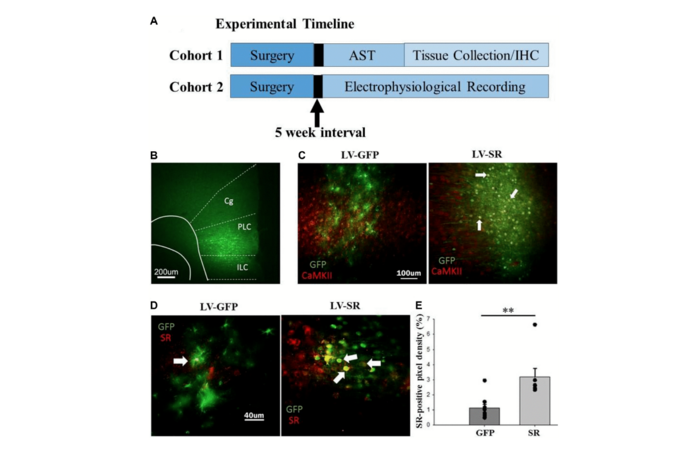“The results from this study support the beneficial effects of the D-serine pathway involvement in NMDAR-mediated transmission and cognitive function […]”

Credit: 2023 Yegla et al.
“The results from this study support the beneficial effects of the D-serine pathway involvement in NMDAR-mediated transmission and cognitive function […]”
BUFFALO, NY- April 19, 2023 – A new research paper was published in Aging (listed by MEDLINE/PubMed as “Aging (Albany NY)” and “Aging-US” by Web of Science) Volume 15, Issue 7, entitled, “Viral vector-mediated upregulation of serine racemase expression in medial prefrontal cortex improves learning and synaptic function in middle age rats.”
An age-associated decrease in N-methyl-D-aspartate receptor (NMDAR)-mediated synaptic function contributes to impaired synaptic plasticity and is associated with cognitive impairments. Levels of serine racemase (SR), an enzyme that synthesizes D-serine, an NMDAR co-agonist, decline with age. In this new study, researchers Brittney Yegla, Asha Rani and Ashok Kumar from the University of Florida’s McKnight Brain Institute predicted that enhancing NMDAR function via increased SR expression in middle age (when subtle declines in cognition emerge) may enhance performance on a prefrontal cortex-mediated task sensitive to aging.
“We hypothesized that augmenting SR expression within mPFC glutamatergic neurons would improve attention and cognitive flexibility in middle-aged rats and facilitate synaptic responses in the mPFC. Thus, for this study, SR expression was upregulated in pyramidal neurons of the mPFC through lenti-viral technology to enhance NMDAR function and evaluate its impact on cognitive flexibility and NMDAR-mediated synaptic transmission in middle-age rats.”
Middle-aged (~12 mo) male Fischer-344 rats were injected bilaterally in the medial prefrontal cortex (mPFC) with viral vector (LV), SR (LV-SR) or control (LV-GFP). Rats were trained on the operant attentional set-shift task (AST) to examine cognitive flexibility and attentional function. LV-SR rats exhibited a faster rate of learning compared to controls during visual discrimination of the AST.
Extradimensional set shifting and reversal were not impacted. Immunohistochemical analyses demonstrated that LV-SR significantly increased SR expression in the mPFC. Electrophysiological characterization of synaptic transmission in the mPFC slices obtained from LV-GFP and LV-SR animals indicated a significant increase in isolated NMDAR-mediated synaptic responses in LV-SR slices. Thus, results of the current study demonstrated that prefrontal SR upregulation in middle age rats can improve learning of task contingencies for visual discrimination and increase glutamatergic synaptic transmission, including NMDAR activity.
“The results from this study support the beneficial effects of the D-serine pathway involvement in NMDAR-mediated transmission and cognitive function, expanding the literature to emphasize its role in not only the hippocampus but also the PFC. Thus, targeting this pathway could pose a potential route in reversing age-related cognitive decline and should be considered for future research.”
Continue Reading: DOI: https://doi.org/10.18632/aging.204652
Corresponding Author: Ashok Kumar
Corresponding Email: [email protected]
Keywords: aging, medial prefrontal cortex, serine racemase, D-serine, NMDA receptor, cognitive flexibility
Sign up for free Altmetric alerts about this article: https://aging.altmetric.com/details/email_updates?id=10.18632%2Faging.204652
About Aging-US:
Launched in 2009, Aging publishes papers of general interest and biological significance in all fields of aging research and age-related diseases, including cancer—and now, with a special focus on COVID-19 vulnerability as an age-dependent syndrome. Topics in Aging go beyond traditional gerontology, including, but not limited to, cellular and molecular biology, human age-related diseases, pathology in model organisms, signal transduction pathways (e.g., p53, sirtuins, and PI-3K/AKT/mTOR, among others), and approaches to modulating these signaling pathways.
Please visit our website at www.Aging-US.com and connect with us:
- SoundCloud
- YouTube
- LabTube
Click here to subscribe to Aging publication updates.
For media inquiries, please contact [email protected].
Aging (Aging-US) Journal Office
6666 E. Quaker Str., Suite 1B
Orchard Park, NY 14127
Phone: 1-800-922-0957, option 1
###
Journal
Aging-US
DOI
10.18632/aging.204652
Method of Research
Experimental study
Subject of Research
Animals
Article Title
Viral vector-mediated upregulation of serine racemase expression in medial prefrontal cortex improves learning and synaptic function in middle age rats
Article Publication Date
12-Apr-2023




